史上最全的英语连读规则
英语连读连音规则

英语连读连音规则英语连读和连音是指在连续的发音中,两个单词之间的辅音音素和元音音素之间会发生变化,使得发音更加流利。
英语连读和连音在口语交流中非常普遍,掌握这些规则可以帮助我们更好地理解和进行口语交流。
以下是一些常见的英语连读和连音规则。
1. 浊辅音和元音相遇:当一个以辅音结尾的单词后面紧跟着一个以元音开头的单词时,辅音音素会发生变化,变成相应的浊辅音音素。
例如,"give me"的发音为/gɪv mi/中的/f/发音成/v/变为/gɪv vi/。
2. 清辅音和元音相遇:当一个以清辅音结尾的单词后面紧跟着一个以元音开头的单词时,清辅音音素会发生变化,变成相应的浊辅音音素。
例如,"big apple"的发音为/bɪɡˈæpəl/中的/ɡ/发音成/ɡ/变为/bɪɡæpəl/。
3. 元音和元音相遇:当两个元音音素相遇时,它们会连起来形成一个准元音或半元音。
例如,"go out"的发音为/ɡoʊ aʊt/中的/o/和/oʊ/连读成/əʊ/变为/ɡəʊ aʊt/。
4. 辅音和辅音相遇:当两个辅音音素相遇时,第一个辅音音素会发生变化,变成相应的浊辅音音素。
例如,"post office"的发音为/poʊstˈɔfɪs/中的/t/发音成/d/变为/poʊs ˈɔfɪs/。
5. 弱读辅音变化:在一些单词中,辅音音素在弱读时会发生变化。
例如,单词"different"的弱读发音为/ˈdɪfrənt/,强读时的/d/变为/ə/。
6. 多音节词时的连读:多音节词中的元音和辅音在连读时会发生变化,使发音更加流利。
例如,"I am"的发音为/aɪæm/中的/aɪ/和/æm/连读成/æm/变为/æm/。
7. 连读时的省略:在连读过程中,有时会省略一些辅音音素或元音音素,以使发音更加流利。
(完整)英语连读规则
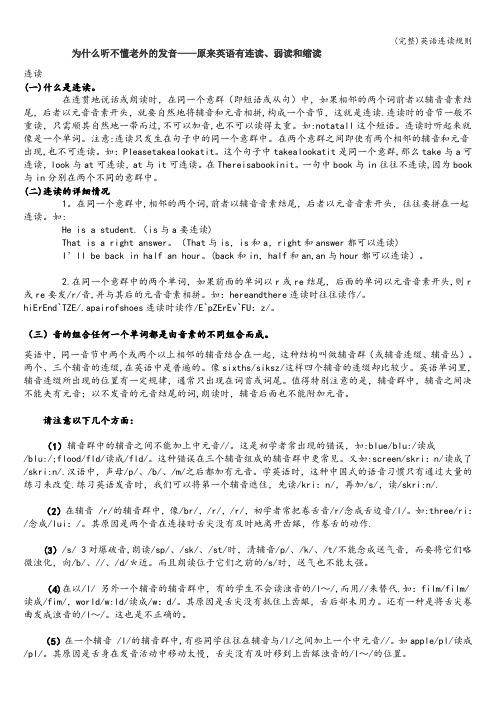
为什么听不懂老外的发音——原来英语有连读、弱读和缩读连读(一)什么是连读。
在连贯地说话或朗读时,在同一个意群(即短语或从句)中,如果相邻的两个词前者以辅音音素结尾,后者以元音音素开头,就要自然地将辅音和元音相拼,构成一个音节,这就是连读.连读时的音节一般不重读,只需顺其自然地一带而过,不可以加音,也不可以读得太重。
如:notatall这个短语。
连读时听起来就像是一个单词。
注意:连读只发生在句子中的同一个意群中。
在两个意群之间即使有两个相邻的辅音和元音出现,也不可连读。
如:Pleasetakealookatit。
这个句子中takealookatit是同一个意群,那么take与a可连读,look与at可连读,at与it可连读。
在Thereisabookinit。
一句中book与in往往不连读,因为book 与in分别在两个不同的意群中。
(二)连读的详细情况1。
在同一个意群中,相邻的两个词,前者以辅音音素结尾,后者以元音音素开头,往往要拼在一起连读。
如:He is a student.(is与a要连读)That is a right answer。
(That与is,is和a,right和answer都可以连读)I’ll be back in half an hour。
(back和in,half和an,an与hour都可以连读)。
2.在同一个意群中的两个单词,如果前面的单词以r或re结尾,后面的单词以元音音素开头,则r 或re要发/r/音,并与其后的元音音素相拼。
如:hereandthere连读时往往读作/。
hiErEnd`TZE/.apairofshoes连读时读作/E`pZErEv`FU:z/。
(三)音的组合任何一个单词都是由音素的不同组合而成。
英语中,同一音节中两个或两个以上相邻的辅音结合在一起,这种结构叫做辅音群(或辅音连缀、辅音丛)。
两个、三个辅音的连缀,在英语中是普遍的。
像sixths/siksz/这样四个辅音的连缀却比较少。
英语连读的12条规则

英语连读的12条规则《英语连读的12条规则》英语连读是一种很有趣的现象,就像搭积木一样,把单词们巧妙地组合在一起,让你的英语说得更流畅。
那咱就来看看这12条规则吧。
规则一:辅音 + 元音连读在一个单词以辅音结尾,下一个单词以元音开头的时候,这两个音就连读啦。
比如说“look at”,读起来就像“loo - kat”,而不是分开的“look”和“at”。
这就像是两个人手拉手,成为一个小团体。
可别把它们分开读哦,要是分开读就会显得很生硬,就像本来一起走路的两个人突然各走各的,多奇怪呀。
规则二:r/re + 元音连读如果单词以r或者re结尾,后面跟着元音开头的单词,那这个r或者re就要和后面的元音连读。
像“far away”,就读成“fa - ra - way”。
这就好比r或者re是个小尾巴,一下子就勾住后面的元音了。
可别忘记这个小尾巴的作用哦,要是不连读,听起来就不是那么顺溜啦。
规则三:相同或相似辅音连读当两个相同或者相似的辅音相邻的时候,只读一次这个辅音,而且要把音拉长一点。
例如“big gun”,不是读“big - gun”,而是“bi - ggun”。
这就像两个长得很像的双胞胎,没必要分开介绍两次,一起介绍就好啦。
要是分开读,就有点啰嗦了。
规则四:元音 + 元音连读如果前一个单词以元音结尾,后一个单词以元音开头,那中间会加一个小的“y”或者“w”的音。
像“go out”,就读成“go - wout”。
这就像是给两个元音之间搭个小桥梁,让它们能顺利连接起来。
要是不搭这个桥,读起来就会有停顿的感觉,就不那么流畅了。
规则五:h音的省略与连读当h开头的单词前面是辅音结尾的单词时,这个h音经常会被省略,然后前面的辅音和h后面的元音连读。
比如“let him”,读成“le - tim”。
这就像h这个小捣蛋鬼突然消失了,然后其他的音就凑到一起玩了。
不过要注意哦,不是所有情况h都能省略的,得是这种前面是辅音结尾的情况。
英语连读规则大全
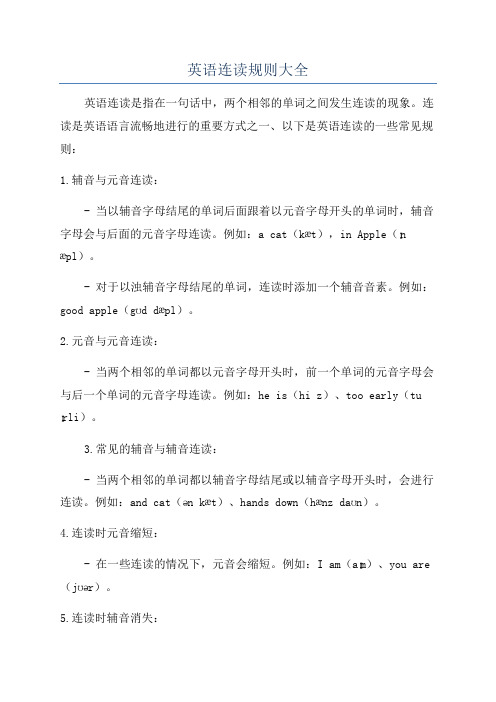
英语连读规则大全英语连读是指在一句话中,两个相邻的单词之间发生连读的现象。
连读是英语语言流畅地进行的重要方式之一、以下是英语连读的一些常见规则:1.辅音与元音连读:- 当以辅音字母结尾的单词后面跟着以元音字母开头的单词时,辅音字母会与后面的元音字母连读。
例如:a cat(kæt),in Apple(ɪnæpl)。
- 对于以浊辅音字母结尾的单词,连读时添加一个辅音音素。
例如:good apple(gʊd dæpl)。
2.元音与元音连读:- 当两个相邻的单词都以元音字母开头时,前一个单词的元音字母会与后一个单词的元音字母连读。
例如:he is(hi z)、too early(tu ɪrli)。
3.常见的辅音与辅音连读:- 当两个相邻的单词都以辅音字母结尾或以辅音字母开头时,会进行连读。
例如:and cat(ən kæt)、hands down(hænz daʊn)。
4.连读时元音缩短:- 在一些连读的情况下,元音会缩短。
例如:I am(aɪm)、you are (jʊər)。
5.连读时辅音消失:- 在一些连读的情况下,辅音会消失或减轻发音。
例如:this is(ðɪz)、have to(hæftʊ)。
6.连读时辅音变化:- 在一些连读的情况下,辅音会发生变化。
例如:at the(ædə)、had to(hædə)。
7.连读时舌尖音符号变化:- 当相邻的词以舌尖音符号结尾时,会变成舌根音符号。
例如:thick hair(θɪɡ keər)。
8.冠词与名词的连读:- 当冠词"the"与以元音字母开头的名词相连时,发生连读。
例如:the apple(ði æpl)。
9.数词与名词的连读:- 在一些情况下,当以单数的数词开头的名词连读时,数词的发音会变得更轻,名词的发音会变得更强。
英语连读规则(完整版)+常见的连读短语及句子
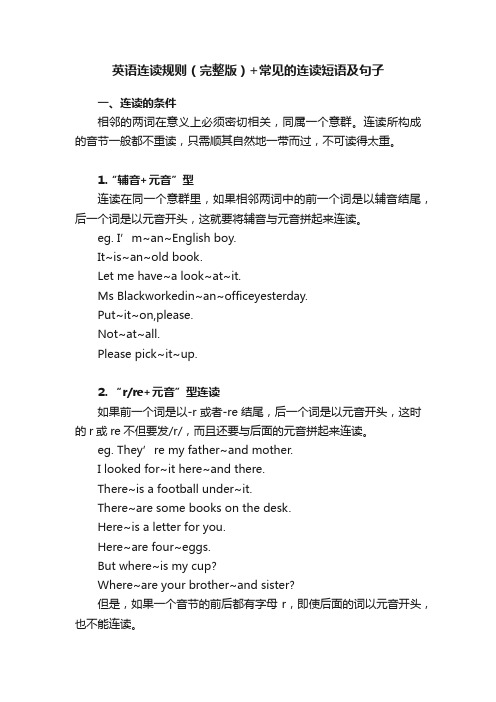
英语连读规则(完整版)+常见的连读短语及句子一、连读的条件相邻的两词在意义上必须密切相关,同属一个意群。
连读所构成的音节一般都不重读,只需顺其自然地一带而过,不可读得太重。
1.“辅音+元音”型连读在同一个意群里,如果相邻两词中的前一个词是以辅音结尾,后一个词是以元音开头,这就要将辅音与元音拼起来连读。
eg. I’m~an~English boy.It~is~an~old book.Let me have~a look~at~it.Ms Blackworkedin~an~officeyesterday.Put~it~on,please.Not~at~all.Please pick~it~up.2. “r/re+元音”型连读如果前一个词是以-r或者-re结尾,后一个词是以元音开头,这时的r或re不但要发/r/,而且还要与后面的元音拼起来连读。
eg. They’re my father~and mother.I looked for~it here~and there.There~is a football under~it.There~are some books on the desk.Here~is a letter for you.Here~are four~eggs.But where~is my cup?Where~are your brother~and sister?但是,如果一个音节的前后都有字母r,即使后面的词以元音开头,也不能连读。
The black clouds are coming nearer and nearer.(nearer与and不可连读)3.“辅音+半元音”型连读英语语音中的/j/和/w/是半元音,如果前一个词是以辅音结尾,后一个词是以半元音,特别是/j/开头,此时也要连读。
eg. Thank~you.Nice to meet~you.Did~you get there late~again?Would~you like~a cup~of tea?Could~you help me, please?“音的同化”—常把/d/+/j/读成/dV/,did you听上成了/dIdVu/,would you成了 /wudVu/,could you成了 /kudVu/4.“元音+元音”型连读如果前一个词以元音结尾,后一个词以元音开头,这两个音往往也要自然而不间断地连读到一起。
英语发音连读失去爆破重读弱读英语中常见的发音规则及现象入门必备

英语发音连读失去爆破重读弱读英语中常见的发音规则及现象入门必备英语发音中的连读、爆破、重读和弱读是非常重要的一些规则和现象。
了解这些规则和现象可以帮助我们更清晰地理解和发音英语。
以下是一些关于这些规则和现象的入门必备知识。
连读(Liaison)连读是指在英语连续的音节之间,辅音和元音之间的连接。
这个现象使得英语的发音更流畅,并且能够帮助我们更好地识别和理解一些单词和短语。
以下是一些常见的连读规则:1. 辅音+辅音:当一个单词以辅音结尾,下一个单词以辅音开头时,这两个辅音会连读。
例如,“good day”连读成[gud deɪ]。
2. 元音+元音:当一个单词以元音结尾,下一个单词以元音开头时,两个元音会连读。
例如,“see it”连读成[si ɪt]。
3. 元音+辅音:当一个单词以元音结尾,下一个单词以辅音开头时,两个单词之间通常用连音符连接。
例如,“a dog”连读成[eɪ.dɒɡ]。
爆破(Aspiration)爆破是指在一些情况下,当辅音出现在一个重读的音节开头时,它们会带有气流的爆破音效。
以下是一些常见的爆破规则:1. 发/p/音:在一个重读的单词开头或音节开头,/p/音通常会带有更强烈的气流爆破效果。
例如,“pat” 发音为“pæt”。
2. 发/t/音:在一个重读的单词开头或音节开头,/t/音通常会带有更强烈的气流爆破效果。
例如,“top” 发音为“tɒp”。
3. 发/k/音:在一个重读的单词开头或音节开头,/k/音通常会带有更强烈的气流爆破效果。
例如,“cat” 发音为“kæt”。
重读和弱读(Stress and Weak Forms)在英语中,一些词和音节有重音(也称为强读),而其他词和音节则有弱音(也称为弱读)。
以下是一些常见的重读和弱读规则:1. 重读:在一个多音节的单词中,通常有一个音节被重读。
例如,“banana”中的重读音节是第一音节,发音为“bəˈnænə”。
史上最全最全的英语连读规则
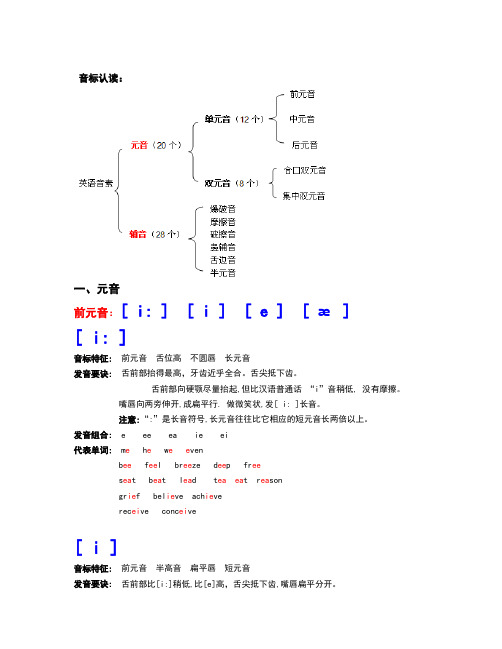
音标认读:一、元音前元音:[ i: ] [ i ] [ e ] [ æ ][ i: ]音标特征:前元音舌位高不圆唇长元音发音要诀:舌前部抬得最高,牙齿近乎全合。
舌尖抵下齿。
舌前部向硬颚尽量抬起,但比汉语普通话“i”音稍低, 没有摩擦。
嘴唇向两旁伸开,成扁平行. 做微笑状,发[ i: ]长音。
注意:“:”是长音符号,长元音往往比它相应的短元音长两倍以上。
发音组合: e ee ea ie ei代表单词: m e h e w e e venb ee f ee l br ee ze d ee p fr ees ea t b ea t l ea d t ea ea t r ea songr ie f bel ie ve ach ie verec ei ve conc ei ve[ i ]音标特征: 前元音半高音扁平唇短元音发音要诀: 舌前部比[i:]稍低,比[e]高,舌尖抵下齿,嘴唇扁平分开。
牙床也开得稍大一些比[ i:]稍宽,比[ e ]窄。
上下齿之间的距离大约可以容纳一个小指尖。
使下颚稍稍下垂,舌前部也随之稍稍下降,即可发出短促[ i ]音。
发音组合: i代表单词: s i t b i t k i ck p i ck w i sh音标对比: [ i: ] [ i ]s ea t s i tb ea t b i tsh ee p sh i p[ e ]音标特征:前元音半高音不圆唇短元音发音要诀:舌尖抵下齿, 舌前部稍抬起, 舌后接近硬颚, 比[ i:] 低。
牙床也开得半开半合,比[ i:] 宽,整体做微笑状。
上下齿之间的距离大约相当于一个食指尖。
发音组合: e ea a代表单词:p e n t e n b e st b e g e gg n e tbr ea d h ea venm a rry a ny m a ny音标对比:[ i ] [ e ]s i t s e tl i ft l e ftd i d d ea d[æ]音标特征: 前元音低舌音不圆唇短元音发音要诀: 舌前部最低,双唇向两旁平伸,成扁平行牙床开的最大。
英语连读规则总结
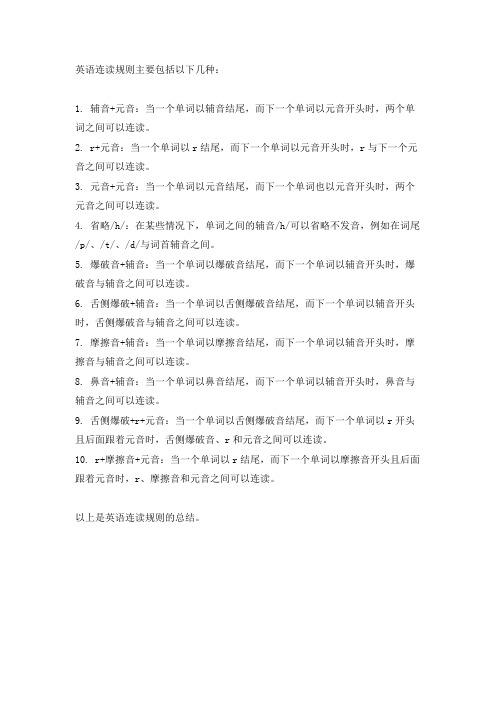
英语连读规则主要包括以下几种:
1. 辅音+元音:当一个单词以辅音结尾,而下一个单词以元音开头时,两个单词之间可以连读。
2. r+元音:当一个单词以r结尾,而下一个单词以元音开头时,r与下一个元音之间可以连读。
3. 元音+元音:当一个单词以元音结尾,而下一个单词也以元音开头时,两个元音之间可以连读。
4. 省略/h/:在某些情况下,单词之间的辅音/h/可以省略不发音,例如在词尾/p/、/t/、/d/与词首辅音之间。
5. 爆破音+辅音:当一个单词以爆破音结尾,而下一个单词以辅音开头时,爆破音与辅音之间可以连读。
6. 舌侧爆破+辅音:当一个单词以舌侧爆破音结尾,而下一个单词以辅音开头时,舌侧爆破音与辅音之间可以连读。
7. 摩擦音+辅音:当一个单词以摩擦音结尾,而下一个单词以辅音开头时,摩擦音与辅音之间可以连读。
8. 鼻音+辅音:当一个单词以鼻音结尾,而下一个单词以辅音开头时,鼻音与辅音之间可以连读。
9. 舌侧爆破+r+元音:当一个单词以舌侧爆破音结尾,而下一个单词以r开头且后面跟着元音时,舌侧爆破音、r和元音之间可以连读。
10. r+摩擦音+元音:当一个单词以r结尾,而下一个单词以摩擦音开头且后面跟着元音时,r、摩擦音和元音之间可以连读。
以上是英语连读规则的总结。
史上最全的英语连读规则一网打尽
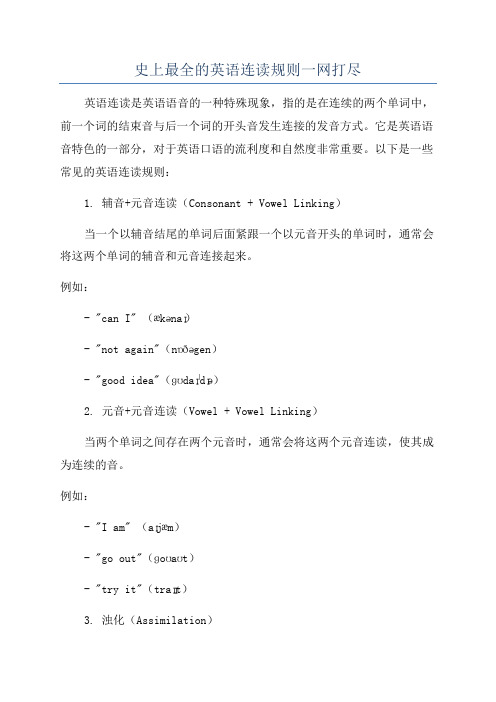
史上最全的英语连读规则一网打尽英语连读是英语语音的一种特殊现象,指的是在连续的两个单词中,前一个词的结束音与后一个词的开头音发生连接的发音方式。
它是英语语音特色的一部分,对于英语口语的流利度和自然度非常重要。
以下是一些常见的英语连读规则:1. 辅音+元音连读(Consonant + Vowel Linking)当一个以辅音结尾的单词后面紧跟一个以元音开头的单词时,通常会将这两个单词的辅音和元音连接起来。
例如:- "can I" (ækənaɪ)- "not again"(nɒðəgen)- "good idea"(ɡʊdaɪˈdɪə)2. 元音+元音连读(Vowel + Vowel Linking)当两个单词之间存在两个元音时,通常会将这两个元音连读,使其成为连续的音。
例如:- "I am" (aɪjæm)- "go out"(ɡoʊaʊt)- "try it"(traɪɪt)3. 浊化(Assimilation)当一个以清辅音结尾的单词后面紧跟一个以辅音开头的单词时,清辅音(如/p/,/t/,/k/等)通常会变成其相应的浊辅音(如/b/,/d/,/ɡ/等)。
例如:- "cup of tea"(kʌbəvˈtiː)- "that guy"(ðæɡaɪ)- "big dog"(bɪdoɡ)4. 借音(Epenthesis)当一个以元音结尾的单词后面紧跟一个以辅音开头的单词时,在这两个单词之间通常会插入一个短促的/i/音(schwa)。
例如:- "crazy idea"(kreɪziˈaɪdiə)- "my old"(maɪoʊld)5. 弱元音免略(Weak Vowel Deletion)在一些情况下,一个单词中的弱元音(如/i/,/ə/)可能会被省略掉,使得两个单词的发音更加流畅。
英语连读六大规则

英语连读六大规则英语连读是指在连续的两个单词之间,一个词以元音音素结尾,而下一个词以元音音素开头时,两个词的辅音音素之间会发生连读的现象。
这有助于提高语音的流畅度。
以下是英语连读的六大规则:1. 辅音+ 元音:- 当一个词以辅音结尾,而下一个词以元音开头时,两个词之间通常发生连读。
例如:"go out" 中的"go" 和"out" 在语音上形成连读。
2. 元音+ 元音:- 如果一个词以元音结尾,而下一个词也以元音开头,通常会发生连读。
例如:"I am" 中的"I" 和"am" 在语音上形成连读。
3. 浊音+ 有声辅音:- 当一个词以浊音(voiced sound)结尾,而下一个词以有声辅音(voiced consonant)开头时,通常发生连读。
例如:"it's time" 中的"it's" 和"time" 在语音上形成连读。
4. 清音+ 无声辅音:- 当一个词以清音(voiceless sound)结尾,而下一个词以无声辅音(voiceless consonant)开头时,通常发生连读。
例如:"big cat" 中的"big" 和"cat" 在语音上形成连读。
5. 双辅音+ 元音:- 当一个词以两个辅音相连,而下一个词以元音开头时,通常发生连读。
例如:"last apple" 中的"last" 和"apple" 在语音上形成连读。
6. 相同辅音:- 如果两个相邻的词有相同的辅音,它们通常会发生融合,形成一个较长的辅音。
例如:"have eggs" 中的"have" 和"eggs" 在语音上形成融合。
英语连读规律(很全面)
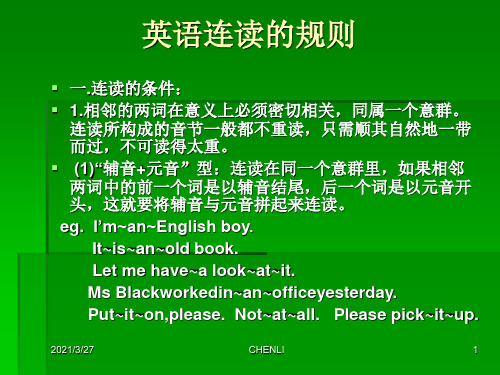
▪ “音的同化”—常把/d/+/j/读成/dV/,did you听 上成了/dIdVu/,would you成了/wudVu/, could you成了/kudVu/。
2021/3/27
CHENLI
3
▪ 4.“元音+元音”型连读:如果前一个词以元音结尾,后一 个词以元音开头,这两个音往往也要自然而不间断地连 读到一起。
是以辅音结尾,后一个词是以半元音,特别是/j/ 开头,此时也要连读。
▪ eg. Thank~you.
▪ Nice to meet~you.
▪ Did~you get there late~again?
▪ Would~you like~a cup~of tea?
▪ Could~you help me, please?
英语连读的规则
▪ 一.连读的条件: ▪ 1.相邻的两词在意义上必须密切相关,同属一个意群。
连读所构成的音节一般都不重读,只需顺其自然地一带 而过,不可读得太重。
▪ (1)“辅音+元音”型:连读在同一个意群里,如果相邻 两词中的前一个词是以辅音结尾,后一个词是以元音开 头,这就要将辅音与元音拼起来连读。
2021/3/27
CHENLI
英语连读的规则

英语连读的规则
英语连读是一种快速、自然的语音表达方式,在英语口语中广泛使用。
其规则如下:
1. 声母连读:单词的结尾是辅音,下一个单词的开头也是辅音时,两个辅音顺序相连形成一个新的辅音。
比如:“cupboard is”连读为[kʌpbɔrdɪz]。
2. 元音连读:相邻的两个单词都以元音结尾或开头时,连读成一个长元音或双元音。
比如:“she is”连读为[ʃi:z]。
3. 省略连接词的连读:在口语中,常省略连接词进行连读。
比如:“I'm gonna”连读为[aɪm'gʌnə]。
4. 连读的速度和语调:口语中连读的速度要比书面语要快,需要注意语调的变化,重读和弱读的变化,这样才能让连读表达更加自然。
总之,英语连读是英语口语中不可或缺的一部分,需要注意练习和灵活使用。
英语中的一些连读

英语中的一些连读在英文中,最常见的七大连读规则是:辅音连读辅音(Linking Consont to Consonant):当一个词的末尾辅音与下一个词的开头辅音相同时,在发音时不会有停顿,而是将辅音音素保持稍微更长的时间。
例如,将 "what time" 连读为 "wha/t/ime",连读时将第一个词的最后一个 /t/ 音和第二个词的第一个 /t/ 音连读在一起,发音为"wha/t/ime"。
其他的例子包括 "bad dog" 连读为 "badog"、"went to" 连读为 "wento"、"gas station" 连读为"gastation" 等。
需要注意的是,如果第一个词以 /ʧ/ 和 /ʤ/ 音结尾,并且第二个词以相同的辅音音素开始,需要分别发出两个音素。
辅音连读元音(Linking Consonant to Vowel):当第一个词以辅音音素结尾,而下一个词以元音音素开始时,在发音时将辅音音素延续到下一个词中。
例如,将 "take it" 连读为 "teɪk ət",其中第二个词 "it" 中的 /ɪ/ 音被简化为弱元音音素。
其他的例子包括 "work at" 连读为 "wɝkət"、"leave it" 连读为"liːvət"、"come around" 连读为 "kəməˈraʊnd"、"some of" 连读为 "səməv"、"look alike" 连读为 "ləkəˈlaɪk" 等。
史上最全的英语连读规则

史上最全的英语连读规则英语连读规则是指在口语中,为了使句子更加流利自然,有些相邻的词之间的辅音或元音会发生连读的现象。
掌握英语连读规则对于提高口语流利度和听力理解能力都具有重要意义。
下面是史上最全的英语连读规则,详细介绍了各种情况下的连读规则。
1.辅音与元音的连读:-当一个以辅音结尾的词与下一个以元音开头的词相遇时,辅音会连读到下一个词的元音上。
例如:I am (aiyem),in a (ina),good idea (gudidea)。
2.辅音与辅音的连读:-当一个以辅音结尾的词与下一个以辅音开头的词相遇时,辅音之间会发生连读,通常省略掉前一个辅音的声音。
例如:that cat (thækæt),in need (inni:d),make cakes (meikkeiks)。
3.元音与元音的连读:-当一个以元音结尾的单词与下一个以元音开头的词相遇时,通常在两个元音之间加入一个连字符或者辅音会发生衔接。
例如:sea and (si:ænd),go out (gəʊæʊt),how are you(haʊəju:)。
4.元音与"h"的连读:-当一个以元音结尾的词与下一个以"h"开头的词相遇时,通常在两个元音之间加入一个连字符或者"h"的声音发生衔接。
例如:go home (gəuhəʊm),see him (si:i:m),do homework (du:həʊmwɜ:k)。
5.辅音词与“r”的连读:-当一个以辅音结尾的词与下一个以"r"开头的词相遇时,辅音前的声音会加长,并且与"r"的声音连读在一起。
例如:car rental (ka:rrentəl),four rooms (fɔ:r ru:mz),red rose (rɛdrəʊz)。
6.两个"r"的连读:-当两个"r"相遇时,第一个"r"发音并且与第二个"r"连读在一起。
史上最全的英语连读规则一网打尽收藏

史上最全的英语连读规则一网打尽收藏英语连读是指在连续说话时,辅音和元音之间发声不分开,而是合在一起发出。
它是英语语音的一个重要特点,也是英语流利口语的重要组成部分。
下面是一些常见的英语连读规则。
1.辅音+元音连读:当一个以辅音结尾的单词后面接一个以元音开头的单词时,通常会将辅音的发音与元音连在一起发音。
例子:- an apple(æn ˈæpl)–这里的“n”和“æ”的发音连成一体,与下一个词“apple”的开头元音“æ”连在一起。
- in English(ɪn ˈɪŋglɪʃ)–这里的“n”和“ɪ”的发音连成一体,与下一个词“English”的开头元音“ɪ”连在一起。
2.元音+元音连读:当一个以元音结尾的单词后面接一个以元音开头的单词时,通常会将两个元音连在一起发音。
例子:- go out(ɡoʊ aʊt)–这里的“o”和“a”的发音连成一体,与下一个词“out”的开头元音“a”连在一起。
- see it(si ɪt)–这里的“e”和“i”的发音连成一体,与下一个词“it”的开头元音“i”连在一起。
3.辅音+辅音连读:当一个以辅音结尾的单词后面接一个以辅音开头的单词时,通常会省略掉中间的元音,并将两个辅音连在一起发音。
例子:- black cat(blæk kæt)–这里的“k”和“c”的发音连成一体,辅音“k”被重复使用。
4.元音+辅音连读(三个及以上字母的辅音复合):当一个以元音结尾的单词后面紧跟一个以三个及以上字母的辅音复合开头的单词时,通常会将两个单词的辅音部分连在一起发音。
例子:- my school(maɪ skuːl)–这里的“s”和“sku”的发音连成一体,与下一个词“school”的开头元音“uː”连在一起。
- high chair(haɪ tʃɛr)–这里的“h”和“tʃ”、“r”的发音连成一体,与下一个词“chair”的开头元音“e”连在一起。
史上最全的英语连读规则

史上最全的英语连读规则英语的连读是指在连续的语音中,两个词之间的辅音与元音之间发生融合。
这种连读现象是英语中常见的语音特点,可以帮助提高口语流利度。
下面是史上最全的英语连读规则:1. 元音连读 (Vocalic Linking)在连续的语音中,当一个单词以元音结尾,下一个单词以元音开头时,两个元音合在一起发音。
例句:I am (aiæm), go on (gəʊɒn)。
2. 辅音连读 (Consonantal Linking)在连续的语音中,两个辅音之间发生融合,通常是通过将第一个辅音的失去弱化或省略。
3. 浊化连读 (Sonorant Linking)在连续的语音中,辅音后面的元音发音呈现出浊音的特点。
例句:big old (bɪgəʊld), good apple (gʊdæpl)。
4. 辅音音变 (Consonant Mutation)在连续的语音中,辅音的发音会因其后面的辅音或元音的不同而发生变化。
例句:ten boys (tembɔɪz), red hat (ret hæt)。
5. 前元音连读 (Front Vowel Linking)在连续的语音中,两个前元音之间的辅音发生变化,通常是从舌前的发音变为不带前元音的发音。
例句:my aunt (maɪənt), new apple (nuːæpl)。
6. 同化连读 (Assimilatory Linking)在连续的语音中,两个相邻的辅音的发音会相互影响,使得其中一个辅音的发音与另一个更相似。
例句:that car (ðæt kɑː), some people (səmprɪpl)。
7. 倍数词连读 (Multiplier Linking)在连续的语音中,当一个倍数词后面跟着一个名词时,倍数词的结尾辅音会与名词的开头辅音发生融合。
例句:six books (sɪkbʊks), nine apples (naɪnæplz)。
(完整版)英语连读规则(整理版)
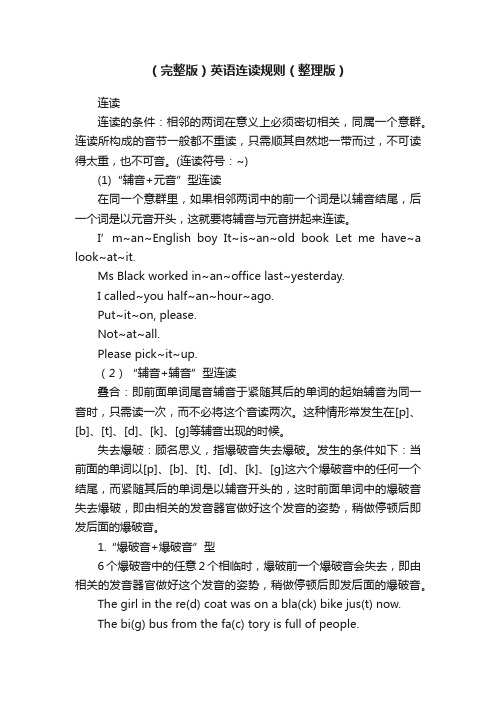
(完整版)英语连读规则(整理版)连读连读的条件:相邻的两词在意义上必须密切相关,同属一个意群。
连读所构成的音节一般都不重读,只需顺其自然地一带而过,不可读得太重,也不可音。
(连读符号:~)(1)“辅音+元音”型连读在同一个意群里,如果相邻两词中的前一个词是以辅音结尾,后一个词是以元音开头,这就要将辅音与元音拼起来连读。
I’m~an~English boy It~is~an~old book Let me have~a look~at~it.Ms Black worked in~an~office last~yesterday.I called~you half~an~hour~ago.Put~it~on, please.Not~at~all.Please pick~it~up.(2)“辅音+辅音”型连读叠合:即前面单词尾音辅音于紧随其后的单词的起始辅音为同一音时,只需读一次,而不必将这个音读两次。
这种情形常发生在[p]、[b]、[t]、[d]、[k]、[g]等辅音出现的时候。
失去爆破:顾名思义,指爆破音失去爆破。
发生的条件如下:当前面的单词以[p]、[b]、[t]、[d]、[k]、[g]这六个爆破音中的任何一个结尾,而紧随其后的单词是以辅音开头的,这时前面单词中的爆破音失去爆破,即由相关的发音器官做好这个发音的姿势,稍做停顿后即发后面的爆破音。
1.“爆破音+爆破音”型6个爆破音中的任意2个相临时,爆破前一个爆破音会失去,即由相关的发音器官做好这个发音的姿势,稍做停顿后即发后面的爆破音。
The girl in the re(d) coat was on a bla(ck) bike jus(t) now.The bi(g) bus from the fa(c) tory is full of people.Wha(t) time does he get up every morning?This is an ol(d) pi(c)ture of a bi(g) car.The ol(d) do(c)tor has a ca(t), too.We’re going to work on a farm nex(t) Tuesday.What would you like, ho(t) tea or bla(ck) coffee?It’s a very col(d) day, but it’s a goo(d) day.You can put i(t) down in the bi(g) garden.I bought a chea(p) book, but it’s a goo(d) book.2.“爆破音+摩擦音”型如果前面是爆破音,其后紧跟着某些摩擦音(如/f/,/s/,/W/,/T/等),那么前面那个爆破音仅有十分轻微的爆破,而后面那个摩擦音则要完全爆破。
(完整版)英语连读规则(整理版)
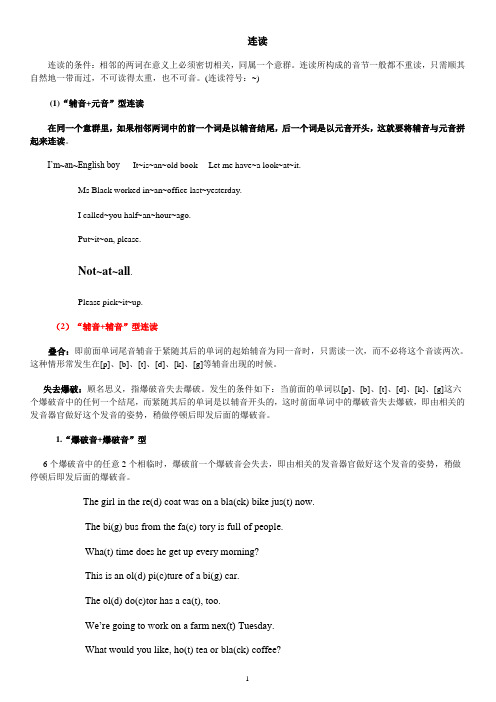
连读连读的条件:相邻的两词在意义上必须密切相关,同属一个意群。
连读所构成的音节一般都不重读,只需顺其自然地一带而过,不可读得太重,也不可音。
(连读符号:~)(1)“辅音+元音”型连读在同一个意群里,如果相邻两词中的前一个词是以辅音结尾,后一个词是以元音开头,这就要将辅音与元音拼起来连读。
I’m~an~English boy It~is~an~old book Let me have~a look~at~it.Ms Black worked in~an~office last~yesterday.I called~you half~an~hour~ago.Put~it~on, please.Not~at~all.Please pick~it~up.(2)“辅音+辅音”型连读叠合:即前面单词尾音辅音于紧随其后的单词的起始辅音为同一音时,只需读一次,而不必将这个音读两次。
这种情形常发生在[p]、[b]、[t]、[d]、[k]、[g]等辅音出现的时候。
失去爆破:顾名思义,指爆破音失去爆破。
发生的条件如下:当前面的单词以[p]、[b]、[t]、[d]、[k]、[g]这六个爆破音中的任何一个结尾,而紧随其后的单词是以辅音开头的,这时前面单词中的爆破音失去爆破,即由相关的发音器官做好这个发音的姿势,稍做停顿后即发后面的爆破音。
1.“爆破音+爆破音”型6个爆破音中的任意2个相临时,爆破前一个爆破音会失去,即由相关的发音器官做好这个发音的姿势,稍做停顿后即发后面的爆破音。
The girl in the re(d) coat was on a bla(ck) bike jus(t) now.The bi(g) bus from the fa(c) tory is full of people.Wha(t) time does he get up every morning?This is an ol(d) pi(c)ture of a bi(g) car.The ol(d) do(c)tor has a ca(t), too.We’re going to work on a farm nex(t) Tuesday.What would you like, ho(t) tea or bla(ck) coffee?It’s a very col(d) day, but it’s a goo(d) day.You can put i(t) down in the bi(g) garden.I bought a chea(p) book, but it’s a goo(d) book.2.“爆破音+摩擦音”型如果前面是爆破音,其后紧跟着某些摩擦音(如/f/,/s/,/W/,/T/等),那么前面那个爆破音仅有十分轻微的爆破,而后面那个摩擦音则要完全爆破。
(完整版)英语的发音技巧和连读规则(史上最全最权威)

英语的发音技巧和连读规则A.美语发音的特点1)腹式发音听美音质特别浑厚,听起来共鸣时间很长,甚至带有很浓重的鼻音。
所谓的腹式发音,指的是美式发音讲究的腹腔发声习惯,这和我们汉语遵循的胸腔发声的习惯大大相径庭。
如果想练习最纯正地道的美语,一定要习惯养成腹腔发声的习惯,做到用发音器官的后部发音。
2)字面发音一般单词怎么拼写就怎么发音,发音更具规则性。
比如卷舌音[r]的处理,在美语中只要有字母r,发音的时候就要卷舌;反之,没有字母r,发音就不要卷舌!3)强弱分明在美语中重读和弱读。
美语的节奏是有重读和弱读交替而产生的(the alternation of stressed and unstressed syllables),所以如果我们如果想让自己的话说出来有节奏感,就要重读该重读的音节,弱读该弱读的地方,这就强弱分明的原则。
单词的重音也要注意,我们首先不能随便移动单词的重音,其次要弱读没有重音的音节,最忌把每个音节上,可是我们习惯上会重读第二个音节,这就是习惯的不同,必须纠正。
B.英音发音的特点1、美音的共振焦点(resonance focus),也就是肌肉运动最多的地方,在口腔中后部的舌与腭之间,也就是所谓的“发音靠后”;英音的共振焦点在牙齿前面、嘴唇之间,嘴唇和面部肌肉运动得更多,也就是所谓的“发音靠前”。
2、美音的音调只在音节之间变化,而不在音节之内变化。
音节之内没有音高的滑动(pitch glide);英音则通过音高的滑动来用于强调逻辑上重要的词语。
所谓音高滑动,是指拉长音节并升高音调。
3、有3个主要元音在英音中总是不同。
/o/在美音中是两段式发音,/??/而在英音中前面加上了一个/?/的音,变成了三段式。
英音的/?/短促有力,嘴唇快速滑动,口形变小。
英音的/?:/发音时,双唇要前伸很远,并弯成圆形,只留下很小的开口。
4、有一些音在英音中只是有时不同。
/i:/在单词结尾(尤其是拼写作y或ly)时弱化为/i/,例如pretty、mostly。
- 1、下载文档前请自行甄别文档内容的完整性,平台不提供额外的编辑、内容补充、找答案等附加服务。
- 2、"仅部分预览"的文档,不可在线预览部分如存在完整性等问题,可反馈申请退款(可完整预览的文档不适用该条件!)。
- 3、如文档侵犯您的权益,请联系客服反馈,我们会尽快为您处理(人工客服工作时间:9:00-18:30)。
史上最全的英语连读规则一网打尽你会正确地读以下单词么:feel, fool, heal, wheel, ...你会正确地读以下词组么:I am, s/he is, I always, too often, ...如果你不会正确发音,那么你需要学习连读规则;如果你能够正确发音,但不知道原因,那你更需要学习连读规则——今天,我就模仿赵老湿,来讲一讲英语口语中的连读。
“连读”在英语中叫Word Connections,借用法语的词汇时叫Liaison,读音为[li'eizn]——在这里要多说一句:从法语中借来的词读音一般都比较怪,一定要先查字典再去读它,免得搞错,比如debut ['deibju:]连读的意义连读是语调中非常重要的一个组成要素。
而语调是让别人更好听懂、更好理解的重要途径——语调的正确,比发音的准确还要重要。
因为语调涉及的内容太多,而且很难用文字来描述,所以在这里只讲连读。
可能有人会认为连读会造成别人的理解困难,他们认为:还是把单词一个挨一个地读清楚更容易听明白。
虽然这种说法明显是错误的,但是在这里我也不想浪费文字去反驳,读者们请自行决定是否要阅读或者离开。
一个例子这里是一个连读的例子。
在这个例子里,不仅仅有连读的存在,还包含发音的一些变化,请仔细分辨:书写英语:They tell me that I’m easier to understand.口语连读:theytellme thedaimeasier der-undersdand连读的分类英语中的连读主要有四种:1)辅音+元音的连读(Consonant + Vowel)2)辅音+辅音的连读3)元音+元音的连读4)T, D, S 或 Z + Y的连读1. 辅音+元音的连读一般来说中国人比较熟悉这种连读——前一个词由辅音结尾,后一个词由元音开头,于是就很自然地连起来了,比如:My name is&helli p; [my nay•miz]because I’ve. [b'k'zäiv]pick up on the American intonation… [pi•kə pan the(y) əmer'kəninətənashən]不只是句子中,读字母缩写也可以连读:LA [eh•Lay]读数字时也可以连读:902 5050 [nai•no•too fai•vo•fai•vo]再来几个简单例子:hold on [hol don]turn over [tur nover]tell her I miss her [teller I misser]因为这种连读一般初中生都会,在这里就不详细介绍了,重头戏在后面,马上开演。
2. 辅音+辅音的连读这个很难用文字描述,放到最后再讲。
3. 元音+元音的连读如果前一个词是由元音 [u]结尾,下一个词由元音开头,那么,在 [u]后面加上一个辅音 [w]如果前一个词是由元音 [i]结尾,下一个词由元音开头,那么,在 [i]后面加上一个辅音 [y]只说规则似乎有点不好理解,看例子就明白了。
Go away. [Go(w)away]在电影Big Fish中,巨人Carl说过这句话。
因为巨人说话又慢又重,所以那个w很明显。
再来看一个例子:I also need the other one. [I(y)also need thee(y)other one] 这种连读不能把辅音w或者j发得太重,否则会显得很傻,但是不发这两个辅音的话又会很难念得顺口。
go anywhere [go(w)anywhere]so honest [so(w)honest]through our [through(w)our]you are [you(w)are]he is [he(y)is]do I? [do(w)I?]I asked [I(y)asked]to open [to(w)open]she always [she(y)always]too often [too(w)often]4. T, D, S 或 Z + Y的连读如果前面的单词是以T/D/S/Z结尾,后面的单词是以Y开头(一般是you这个词),那么有如下的连读规则可以使用。
4.1. T + Y = CHWhat’s your name? [wəcher name]Can’t you do it? [kænt chew do(w)it]Actually [æk·chully]Don’t you like it? [dont chew lye kit]Wouldn’t you? [wooden chew]Haven’t you? [hæven chew]No, not yet. [nou, nä chet]I’ll let you know. [I'll letcha know]Can I get you a drink? [k'näi getchewə drink]We thought you weren’t coming. [we thä chew wrnt kəming] I’ll bet you ten bucks he forgot. [æl betcha ten buxee frgät] Is that your final answer? [is thæchr fin'læn sr]natural [næchrəl]perpetual [perpechə(w)əl]virtual [vrchə(w)əl]4.2. D + Y = JDid you see it? [didjə see(y)it]How did you like it? [hæo•jə lye kit]Could you tell? [küjə tell]Where did you send your check? [wεrjə senjer check]What did your family think? [wəjer fæmlee think]Did you find your keys? [didjə fine jer keez]We followed your instructions. [we fallow jerin strəctionz] Congratulations! [k'ngræj'lationz]education [edjə·cation]individual [indəvijə(w)əl]graduation [græjə(w)ation]gradual [græjə(w)əl]4.3. S + Y = SHYes, you are. [yeshu are]Insurance [inshurance]Bless you! [blesshue]Press your hands together. [pressure hanz d'gethr]Can you dress yourself? [c 'new dreshier self]You can pass your exams this year. [yuk'n pæsher egzæmz thisheer]I’ll try to guess your age. [æl trydə geshierage]Let him gas your car for you. [leddim gæshier cär fr you]4.4. Z + Y = ZHHow’s your family? [hæozhier fæmlee]How was your trip? [hæo·wəzhier trip]Who’s your friend? [hoozhier frend]Where’s your mom? [wεrzh'r mäm]When’s your birthday? [wεnzh'r brthday]She says you’re OK. [she sεzhierou kay]Who does your hair? [hoo dəzhier hεr]casual [kæ·zhyə(w)əl]visual [vi·zhyə(w)əl]usual [yu•zhyə(w)əl]version [vrzh'n]vision [vizh'n]附录: 音节省略和连读放在一起I have got to go. [I’ve gotta go.I have got a book. [I’ve gotta book.Do you want to dance? [Wanna dance?Do you want a banana? [Wanna banana?Let me in. [Lemme in.Let me go. [Lemme go.I’ll let you know. [I’ll letcha know.Did you do it? [Dija do it?Not yet. [Nä chet.I’ll meet you later. [I’ll meechu layder.What do you think? [Whaddyu think?What did you do with it? [Whajoo do with it?How did you like it? [Howja like it?When did you get it? [When ju geddit?Why did you take it? [Whyju tay kit?Why don’t you try it? [Why don chu try it?What are you waiting for? [Whaddya waitin’ for?What are you doing? [Whatcha doin’?How is it going? [Howzit going?Where’s the what-you-may-call-it? [Where’s the whatchamacallit?Where’s what-is-his-nam e? [Where’s whatsizname?How about it? [How ’bout it?He has got to hurry because he is late. [He’s gotta hurry ‘cuz he’s late.I could’ve been a contender. [I coulda bina contender.Could you speed it up, please? [Couldjoo spee di dup, pleez? Would you mind if I tried it? [Would joo mindifai try dit? Aren’t you Bob Barker? [Arnchoo Bab Barker?Can’t you see it my way for a change? [Kænchoo see it my way for achange?Don’t you get it? [Doancha geddit?I should have told you. [I shoulda toljoo.Tell her (that) I miss her. [Tell him (that) I miss him. Teller I misser. [Tellim I missim.Did you eat? [Jeet?No, did you? [No, joo?Why don’t you get a job? [Whyncha getta job?I don’t know, it’s too hard. [I dunno, stoo härd.Could we go? [Kwee gou?Let’s go! [Sko!最后的话可能有人会觉得奇怪,为什么在附录之后还有一段。
